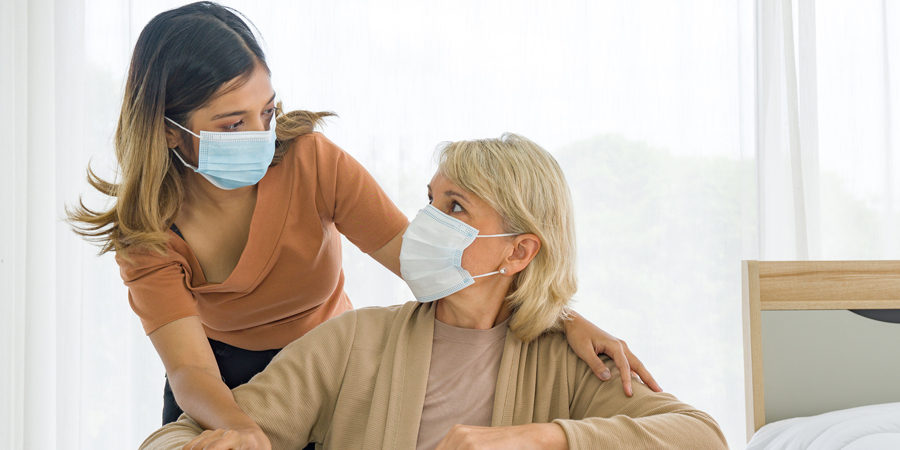Last November marked the lifting of most federal restrictions on nursing homes and their visitors – a long-awaited milestone for senior care. Residents and their families rejoiced as these restrictions led to loneliness at best and the feeling of isolation at worse, over the nearly two years since the COVID-19 pandemic began taking hold in the United States.
For owners and operators of post-acute care facilities, the new guidance from the Centers for Medicare and Medicaid Services (CMS) might evoke mixed feelings. Opening the doors to a wave of visitors potentially increases the risk of transmission of COVID-19, specifically the latest variant Omicron. On the other hand, the prolonged visitor restriction, imposed as a safety precaution, has taken a terrible toll, mentally and physically, on residents and their families.
In issuing its guidance in November, the CMS cited a steep decline in COVID-19 cases and the full vaccination of 86% of nursing home residents and 74% of employees. It is possible, however, that state and local health regulations could supersede the federal rules. In fact, three states have recently reimposed stricter nursing home visitation policies as we learn more about how easily transmittable Omicron is. Rhode Island, California and New York all have varying visitation policies that were all put into place within the past week.
Opening the doors
The CMS guidance directs nursing homes to allow all visits for all residents, while staying vigilant against outbreaks. That means:
- No limits on length or frequency of visits
- No scheduling required
- No limits on number of visitors (large groups are discouraged)
Regardless of vaccination status, all residents and visitors of nursing homes are encouraged to wear masks in shared areas. Facilities should screen for those who have tested positive for the coronavirus or who meet the criteria for quarantine, the CDC says, and prohibit those people from entering.
“We need to let folks back in,” said Colleen O’Rourke, naviHealth Senior Vice President of Network and Clinical Solutions. “The disruption and social isolation for seniors have been traumatic. However, family members and visitors have a social obligation to protect their loved ones when they visit. That may mean being vaccinated; or appropriately masking in the facility, whether they are vaccinated or not; or choosing not to visit when they’re not feeling well. It means being responsible so as not to put seniors at risk.”

Residents at a facility being investigated for an outbreak, as well as those under special precautions to prevent COVID-19 transmission, can still receive visitors, though they and their visitors must wear masks and protective gear. Residents with an unvaccinated or immunocompromised roommate should not receive in-room visitors.
O’Rourke, pointing out that short-staffed facilities do not have the capacity to police potential violations of the visitation policy, urged a “mature approach” by all involved to protect a vulnerable population.
Weighing the risks
Americans in long-term care facilities have been disproportionately affected by the pandemic. While they make up only about 1% of the population, they account for 30% of the deaths.
At the same time, the enforced isolation that began in March 2020 in the name of safety has taken its own heavy toll on the more than 1.3 million people in this country who live in nursing homes, and their families. Although restrictions have gradually been loosened, the pace and degree have varied by state and locality. During that time, many seniors have suffered distress, disorientation and depression, as well as medical setbacks, because of separation from their loved ones. This has renewed attention to seniors’ mental health.
Seniors’ comparative lack of technological savvy or access to web-connected devices makes in-person interaction even more crucial. Most social activities in a nursing home occur in communal spaces, O’Rourke said, pointing to worship services and visits to the hairdresser as well as daily experiences such as meals in the dining room with friends from throughout the building. In addition, family members often take an active role in the resident’s care, making sure their loved one is eating appropriately, receives bathroom assistance or repositioning when necessary.
“I can’t imagine what it was like for loved ones and caregivers when visitation for seniors was cut off,” said O’Rourke, who worked in a post-acute care environment for more than 25 years.
However, as we learn more about Omicron, the decision to reimpose visitor restrictions (at a state and facility level) is real. It will be difficult decision for providers to make but it must be a decision that is respected.
“Nursing home administrators do not want to keep family members out, they understand better than anyone how important visits are,” said O’Rourke. “But they are charged with the responsibility of keeping their residents as healthy and as functional as possible. They cannot do that with one hand tied behind their back. We need to respect the situation these operators are in and work with them, not against them in the fight against COVID-19.”
What nursing homes must do now
There’s no time to celebrate the decision — or to worry about its potential repercussions, for that matter. Owners and operators of long-term care hospitals, inpatient rehab facilities, skilled nursing facilities, home health agencies and other post-acute care facilities must adjust their attention to certain areas beyond the day-to-day mission of caring for their patients.
- Stay vigilant against Omicron. As of last week, the Omicron variant has made up 98% of new US COVID infections.
The Centers for Disease Control and Prevention (CDC) has data that shows the Omicron variant spreads more easily than the original SARS-CoV-2 virus. Anyone infected with Omicron, even if vaccinated or symptom free, could spread the virus to others, the CDC says. The agency expects current vaccines to offer protection against severe illness, hospitalization or death from Omicron infection, even if breakthrough infections occur. “Vaccines remain the best public health measure to protect people from COVID-19, slow transmission, and reduce the likelihood of new variants emerging,” the CDC said.
While that may be good news for the general public, for seniors who are at higher risk of serious illness or experiencing complications from the new variant, extra precautions need to be taken. That responsibility once again falls on the shoulders of post-acute care providers, even if the decision extends to limiting resident interaction with others.
“Now that Omicron has had such a significant spread – It might be important to recognize that individual facilities should have the right to modify and adjust visitor hours/schedules and requirements during high risk times. Not out of an ‘abundance of caution’ but because the risk to even vaccinated seniors is so significant,” said O’Rourke.
- Continue supporting burned-out staff while working to backfill positions. The United States was facing a nursing crisis even before the pandemic. That crisis coincides with the aging of the baby boomer population — all of whom will be 65 or older by 2030, according to the U.S. Census Bureau. Meanwhile, the average age of a U.S. nurse has surpassed 50 years old.
“The nursing crisis is real, and it has accelerated,” O’Rourke said. Low salaries for skilled nursing staff and certified nursing assistants (CNAs), combined with short staffs, overwhelming workloads and burnout, have led to an exodus of nurses, creating a vicious cycle.
“We need to be advocates for the long-term care industry — those who are taking care of our parents and our grandparents,” O’Rourke said. “It’s incredibly difficult work. For people who have an affinity for older folks, keeping them safe, taking care of them and helping them enjoy their golden years is a calling. I don’t know that we give enough grace or recognition to the work that’s being done. These are tough times, and we all need to be in this together and be supportive to have success.”




